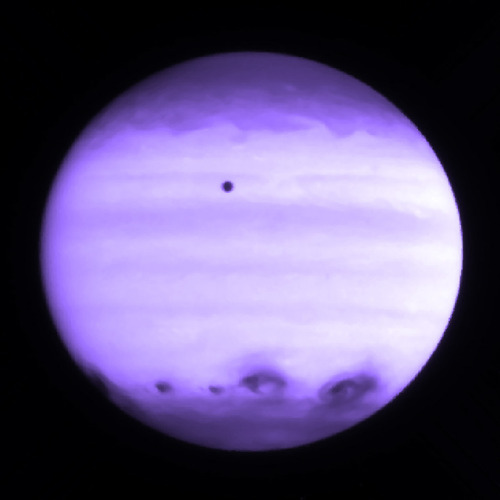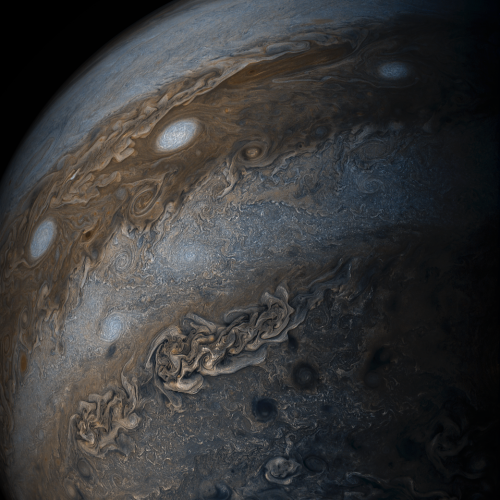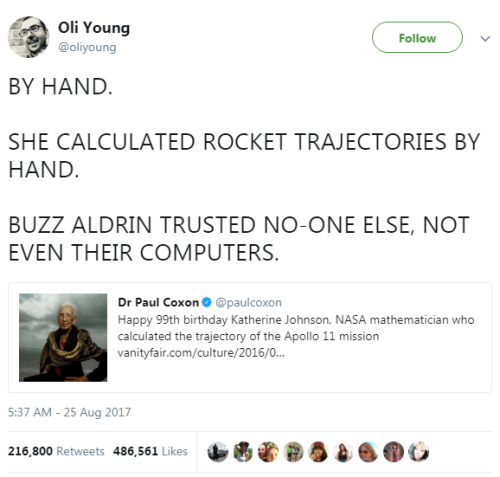Deep Thought Of The Day
Deep Thought of the Day
Over 90% of our solar system actually begins where the planets end. Deep stuff. Yes, the galaxy is interesting, but our own cosmic backyard should pique our interest as well. Lots of interesting things just a hop, skim, and few year journey in a yet-to-be-designed spacecraft.
More Posts from Starlost and Others

Hubble’s view of Jupiter on July 21, 1994. Credit: NASA/Hubble Space Telescope Comet Team
Consider this: You can see less than 1% of the electromagnetic spectrum and hear less than 1% of the acoustic spectrum. As you read this, you are traveling at 220 km/sec across the galaxy. 90% of the cells in your body carry their own microbial DNA and are not “you.” The atoms in your body are 99.9999999999999999% empty space and none of them are the ones you were born with, but they all originated in the belly of a star. Human beings have 46 chromosomes, 2 less than the common potato. The existence of the rainbow depends on the conical photo-receptors in your eyes; to animals without cones, the rainbow does not exist. So you don’t just look at a rainbow, you create it.
NASA Lunar Science Institute, 2012 (via cylon)
![Squidolus [Day:1332 Hour:0]](https://64.media.tumblr.com/35982fa297f66f6066381dbc51dc74aa/325fadba15b2e288-01/s500x750/20fd231146d65a614d8799a7ed76a8acee5e2e19.png)
Squidolus [Day:1332 Hour:0]

Jupiter’s Bands of Clouds
This enhanced-color image of Jupiter’s bands of light and dark clouds was created by citizen scientists Gerald Eichstädt and Seán Doran using data from the JunoCam imager on NASA’s Juno spacecraft.
Three of the white oval storms known as the “String of Pearls” are visible near the top of the image. Each of the alternating light and dark atmospheric bands in this image is wider than Earth, and each rages around Jupiter at hundreds of miles (kilometers) per hour. The lighter areas are regions where gas is rising, and the darker bands are regions where gas is sinking.
Credits: NASA/JPL-Caltech/SwRI/MSSS/Gerald Eichstädt /Seán Doran




She should have a statue. Not those confederate MFs.

“The south pole of Mars, September 1877.” Star-land : being talks with young people about the wonders of the heavens. 1892.
![Squidolus [Day:1323 Hour:12]](https://64.media.tumblr.com/642d11218acb2fdc6d9f85cd9d68274e/740f0e36da891d33-b4/s500x750/a5fb82ea794308bf702bfbec68a5f367866ba754.png)
Squidolus [Day:1323 Hour:12]

Galaxy Collision Creates ‘Space Triangle’ in New Hubble Image by NASA Hubble
![The Lightest (i.e., Least Massive) Known Star, OTS 44 [3000 X 2400]](https://64.media.tumblr.com/7ce349b6a3bf21005fa9d453fc4e3790/tumblr_n6d9w27NCh1tuy5mao1_500.jpg)
The lightest (i.e., least massive) known star, OTS 44 [3000 x 2400]
-
 gent258 liked this · 6 years ago
gent258 liked this · 6 years ago -
 warrenjones1958 liked this · 6 years ago
warrenjones1958 liked this · 6 years ago -
 kitsophx liked this · 7 years ago
kitsophx liked this · 7 years ago -
 quinnpatrol liked this · 7 years ago
quinnpatrol liked this · 7 years ago -
 nickjw24 liked this · 7 years ago
nickjw24 liked this · 7 years ago -
 57dad19-blog liked this · 7 years ago
57dad19-blog liked this · 7 years ago -
 dodge6976 liked this · 7 years ago
dodge6976 liked this · 7 years ago -
 tunertommy liked this · 7 years ago
tunertommy liked this · 7 years ago -
 coleybeach liked this · 7 years ago
coleybeach liked this · 7 years ago -
 maximusbearimus-blog liked this · 7 years ago
maximusbearimus-blog liked this · 7 years ago -
 lifebyproxy liked this · 7 years ago
lifebyproxy liked this · 7 years ago -
 livelifeasitlays reblogged this · 7 years ago
livelifeasitlays reblogged this · 7 years ago -
 livelifeasitlays liked this · 7 years ago
livelifeasitlays liked this · 7 years ago -
 efuru88-blog liked this · 7 years ago
efuru88-blog liked this · 7 years ago -
 bagelson reblogged this · 7 years ago
bagelson reblogged this · 7 years ago -
 star-thrower liked this · 7 years ago
star-thrower liked this · 7 years ago -
 charoulito liked this · 8 years ago
charoulito liked this · 8 years ago -
 fxckingkawaii liked this · 8 years ago
fxckingkawaii liked this · 8 years ago -
 nosense-in liked this · 8 years ago
nosense-in liked this · 8 years ago -
 zuhairiirfan0404-blog liked this · 8 years ago
zuhairiirfan0404-blog liked this · 8 years ago -
 kaylin2569-blog liked this · 8 years ago
kaylin2569-blog liked this · 8 years ago -
 rep1070 liked this · 8 years ago
rep1070 liked this · 8 years ago -
 theskyismadeofpenguins liked this · 8 years ago
theskyismadeofpenguins liked this · 8 years ago -
 austinmshaw liked this · 8 years ago
austinmshaw liked this · 8 years ago -
 thelovelyunknownnn liked this · 8 years ago
thelovelyunknownnn liked this · 8 years ago -
 steppenwolf-1 liked this · 8 years ago
steppenwolf-1 liked this · 8 years ago -
 anonymous2017new liked this · 8 years ago
anonymous2017new liked this · 8 years ago -
 dogboydeathgrips reblogged this · 8 years ago
dogboydeathgrips reblogged this · 8 years ago -
 dogboydeathgrips liked this · 8 years ago
dogboydeathgrips liked this · 8 years ago -
 timallenphoto liked this · 8 years ago
timallenphoto liked this · 8 years ago -
 wellrounded-infinitelyminded reblogged this · 8 years ago
wellrounded-infinitelyminded reblogged this · 8 years ago -
 itzmeeh0680-blog liked this · 8 years ago
itzmeeh0680-blog liked this · 8 years ago -
 tahinisause reblogged this · 8 years ago
tahinisause reblogged this · 8 years ago -
 colombianatthedisco reblogged this · 8 years ago
colombianatthedisco reblogged this · 8 years ago -
 good-and-colorful liked this · 8 years ago
good-and-colorful liked this · 8 years ago -
 wecameheretoburgleyourturts reblogged this · 8 years ago
wecameheretoburgleyourturts reblogged this · 8 years ago -
 lock-howl reblogged this · 8 years ago
lock-howl reblogged this · 8 years ago -
 mypaperdreams liked this · 8 years ago
mypaperdreams liked this · 8 years ago -
 perfectlywiseobservation liked this · 8 years ago
perfectlywiseobservation liked this · 8 years ago -
 bubble-buddy1 reblogged this · 8 years ago
bubble-buddy1 reblogged this · 8 years ago

andrei, he/him, 21, made this at 14 when i was a space nerd but i never fully grew out of that phase so,,,,..,hubble telescope + alien life + exoplanet + sci fi nerd
245 posts